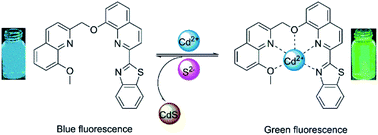A simple fluorescent probe for detection of Ag+ and Cd2+ and its Cd2+ complex for sequential recognition of S2−†
Abstract
In this study, we designed and synthesized a simple probe 2-(8-((8-methoxyquinolin-2-yl)methoxy)quinolin-2-yl)benzo[d]thiazole (DQT) for detection of Ag+ and Cd2+ in a CH3OH/HEPES (9 : 1 v/v, pH = 7.30) buffer system. Its structure was characterized by NMR, ESI-HR-MS and DFT calculations, and its fluorescence performance was also investigated. Probe DQT showed fluorescence quenching in response to Ag+ and Cd2+ with low detection limits of 0.42 μM and 0.26 μM, respectively. Importantly, the complexation of the probe with Cd2+ resulted in a red shift from blue to green, making it possible to detect Ag+ and Cd2+ by the naked eye under an ultraviolet lamp. The DQT-Cd2+ complex could be used for sequential recognition of S2−. The recovery response could be repeated 3 times by alternate addition of Cd2+ and S2−. A filter paper strip test further demonstrated the potential of probe DQT as a convenient and rapid assay.



 Please wait while we load your content...
Please wait while we load your content...